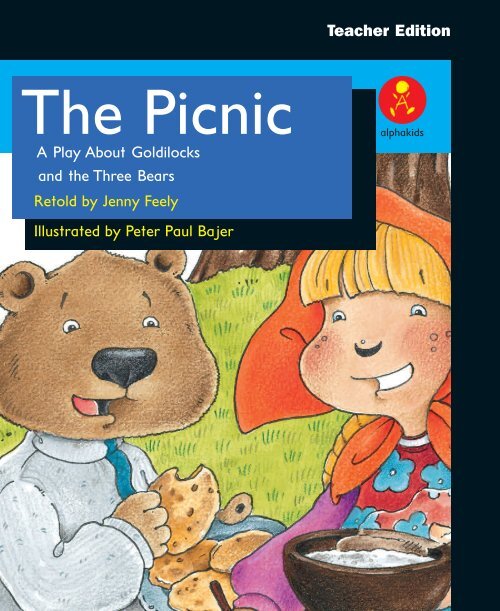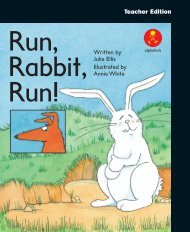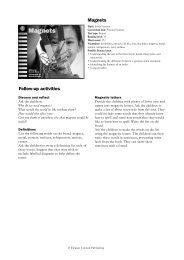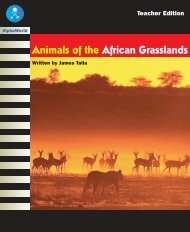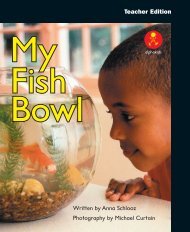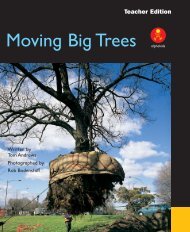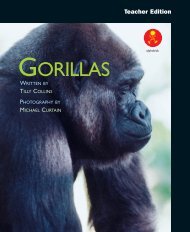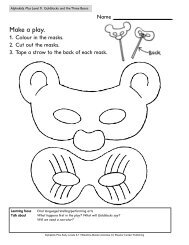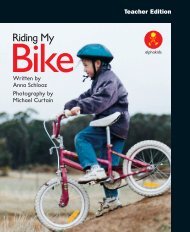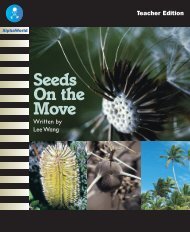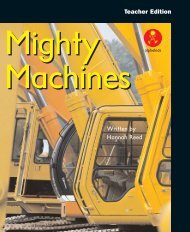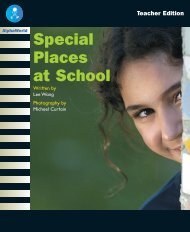Baby Bear The Picnic
Baby Bear The Picnic
Baby Bear The Picnic
- No tags were found...
You also want an ePaper? Increase the reach of your titles
YUMPU automatically turns print PDFs into web optimized ePapers that Google loves.
Teacher Edition<strong>The</strong> <strong>Baby</strong> <strong>Picnic</strong> <strong>Bear</strong>A Play About GoldilocksGoes for a Walkand the Three <strong>Bear</strong>sRetold by Jenny FeelyalphakidsIllustrated by Peter Paul Bajer
Published edition© Eleanor CurtainPublishing 2004First published 2004Apart from any fair dealing forthe purposes of study, research,criticism or review, aspermitted under the CopyrightAct of Australia, no part of thisbook may be reproduced byany process, or transmitted inany form, without permissionof the copyright owner. Wherecopies of part or the whole ofthis book are made under PartVB of the Copyright Act, thelaw requires that records ofsuch copying be kept and thecopyright owner is entitled toclaim payment.Developed byEleanor Curtain PublishingText: Nicole Di MarcoConsultant: Susan HillDesigned byAlexander StittProduction byPublishing SolutionsPrinted in ChinaISBN 0 7253 3414 21 2 3 4 5 6 7 8 904 05 06?How to use this bookBefore reading: TalkthroughTalk through the book with the children. Encouragethem to predict the text from the cover and thepictures, and to think about the information theyprovide. Direct the children’s attention to aspects ofthe text that may challenge them. Support the childrento deal with these challenges by asking theTalkthrough questions on each page.During reading: Observe and supportObserve the children as they read. Encourage them tomonitor their own reading as they comprehend thetext. As needed, support the children by helping themto discover and use reading strategies and cues to solveproblems and respond to reading challenges that arisein the text. Interruptions to the children’s readingshould be minimal and focused on specified learningneeds.After reading: Comprehension, returning tothe text, responding and writing linksTo further develop children’s understanding of thetext, select from activities found on page 16 and theinside back cover. <strong>The</strong>se whole text, sentence and wordlevel activities reinforce the teaching focus of thisbook. Assessment ideas are provided to assist withplanning for further teaching.Text highlights• <strong>The</strong> text continues the story begun inGoldilocks and the Three <strong>Bear</strong>s (level 9) and<strong>Baby</strong> <strong>Bear</strong> Goes Visiting (level 10).• <strong>The</strong> text models the conventions of a playscript, including a cast list, scenes andstage directions.Vocabularycast, friends, herself, himself, honey, narrator,pancakes, pears, picnic, porridge, scene,strawberries
Setting the contextHave you ever seen a play? What was itcalled? Did you enjoy it? What do you knowabout plays?Introducing the bookThis book is written as a play aboutGoldilocks and her family and <strong>Baby</strong> <strong>Bear</strong>and his family, who happen to go on apicnic on the same day.Front coverRead the title to the children.What can you remember about the story ofGoldilocks and the three bears? Look at thefront cover. What things from the originalstory might the author have included in herplay?Title pageHow do you think <strong>Baby</strong> <strong>Bear</strong> is feeling inthis picture? Why might he feel this way?
<strong>The</strong> <strong>Picnic</strong> Pages 2–3?TalkthroughDiscuss the cast of characters.A cast of characters is provided at the beginning of most plays.It tells us the names of the characters who will appear in theplay. Who are the characters in this play?Where is scene one set? Who says the opening words in theplay? What is the job of the Narrator?Observe and supportDo the children understand new terminology?What is a cast list?2
<strong>The</strong> <strong>Picnic</strong> Pages 4–5?TalkthroughWhat does each bear want to take on the picnic? Why doesPapa <strong>Bear</strong> want to take lots of porridge rather than pancakes?Where does it tell you this?Observe and supportDo the children search for a range of information onthe page to support their reading?When you looked at the pictures before you read the writing,what were you looking for? How did that help you?4
<strong>The</strong> <strong>Picnic</strong> Pages 6–7?TalkthroughWhere is this scene set?What does everyone in Goldilocks’s family want to take on thepicnic?Observe and supportDo the children read the text expressively?Does Goldilocks like porridge? How would she say, ‘And lots andlots of porridge’?6
<strong>The</strong> <strong>Picnic</strong> Pages 8–9?TalkthroughWhere is scene three set?Where does <strong>Baby</strong> <strong>Bear</strong> go to eat his porridge?Observe and supportCan the children use phonic understanding to workout new words such as ‘forest’?Can you break the word up? What sound does it start with?What sound does it finish with?8
<strong>The</strong> <strong>Picnic</strong> Pages 10–11?TalkthroughGoldilocks and her family start to eat their pancakes. Wheredoes Goldilocks go to eat hers?Observe and supportDo the children use a range of information to solveproblems when they read?If a child has difficulty with a word, ask the followingquestions:What can you see that might help you work it out? What couldyou try? What would make sense here?10
<strong>The</strong> <strong>Picnic</strong> Pages 12–13?TalkthroughWhy are there parentheses around ‘to himself’ and ‘to herself’?How should the actors who play Goldilocks and <strong>Baby</strong> <strong>Bear</strong> saythese parts? Let’s read their parts so we can practise how theyshould sound.Observe and supportCan the children demonstrate how to use the stagedirections on the page?What do the stage directions on this page tell us?12
<strong>The</strong> <strong>Picnic</strong> Pages 14–15?TalkthroughLook at the picture. What are Goldilocks and <strong>Baby</strong> <strong>Bear</strong> doing?Do you think this is a good idea? Why?Observe and supportCan the children understand the inferences in the text?How do Goldilocks and <strong>Baby</strong> <strong>Bear</strong> know that it might be a goodidea to swap their meals?14
<strong>The</strong> <strong>Picnic</strong> Page 16? TalkthroughDid you predict this ending? How is it different from whathappened in the two earlier books? Do you like this ending?Why or why not?16After readingBeing a meaning makerEncourage the children to support their responseswith evidence from the book as they discuss thesecomprehension questions:What did <strong>Baby</strong> <strong>Bear</strong> want to take on the picnic? What did heend up with?What did Goldilocks want to take on the picnic? What did sheend up with?Why did Goldilocks and <strong>Baby</strong> <strong>Bear</strong> become friends?Are friendships always based on sharing?
Being a code breakerExplore the following language features:• Hearing sounds: read sections of theplay to the children and ask them toclap each time they hear the sound/p/ at the start of a word. Forexample, Papa, picnic, pancakes,porridge, pears.• Play-writing conventions: a cast list,stage directions, scenes, differenttype to indicate which character isspeaking.Being a text userRefer to the text when discussing thesequestions:How can you tell that this book is a playscript?Which part of the book tells you who is in theplay?How do you know whose turn it is to speak?How do you know where the action takesplace?Being a text criticWhy has the author chosen to have Goldilocksliking porridge and <strong>Baby</strong> <strong>Bear</strong> likingpancakes? How does this help the story?Responding to textAsk the children to work incooperative groups to make masksfrom paper plates representing thecharacters in the play. Have them usetheir masks to practise and perform theplay.<strong>The</strong> children could create acharacter portrait using thefollowing framework as a guide.All about …………………..I am …………………………I live ………………………..I have ……………………….I like ………………………...I hate ………………………..I wish ……………………….Ask the children to select twentywords from the book and put themin alphabetical order by first letter.WritingWith a partner, the children could retellthe story as a narrative instead of a playand then compare the narrative form tothe play form. <strong>The</strong>y could make a list ofsimilarities and differences.AssessmentCan the children:• explain the purpose of various features of a play script; for example, a cast list?• explain the purpose of a narrator in a play?whole text activity sentence activity word activity
ALPHAKIDS<strong>The</strong> <strong>Baby</strong> <strong>Picnic</strong> <strong>Bear</strong>A Play About Goldilocksand the Three <strong>Bear</strong>sGoes for a WalkRetold by Jenny FeelyIllustrated by Peter Paul BajeralphakidsTeacherEditionOtherbooksat thislevelalphakidsCircus BoyWritten by Mary-Anne CreasyPhotography by Michael CurtainTopic: Traditional talesCurriculum link: EnglishText type: PlayReading level: 11Word count: 233High-frequency words: a, and, can, for, had, have,her, like, my, no, not, of, off, on, some, take, that,their, the, there, they, to, this, what, we, were, wouldVocabulary: cast, friends, himself, herself, honey,narrator, pancakes, pears, picnic, porridge, scene,strawberriesBillyBananaWritten byJack HastingsIllustrated byChantal StewartalphakidsFlyingMachinesWritten by Mary-Anne CreasyGORILLASWRITTEN BYalphakidsTILLY COLLINSPossible literacy focusUnderstanding the conventions of a play: a cast,scenes and stage directions.Discussing the role of the narrator in a play.PHOTOGRAPHY BYMICHAEL CURTAINSummaryThis book is a play script about Goldilocks and herfamily and <strong>Baby</strong> <strong>Bear</strong> and his family going on apicnic on the same day. It tells how Goldilocks and<strong>Baby</strong> <strong>Bear</strong> become friends.ISBN 0- 7253- 3414- 29 780725 334147alphakids


